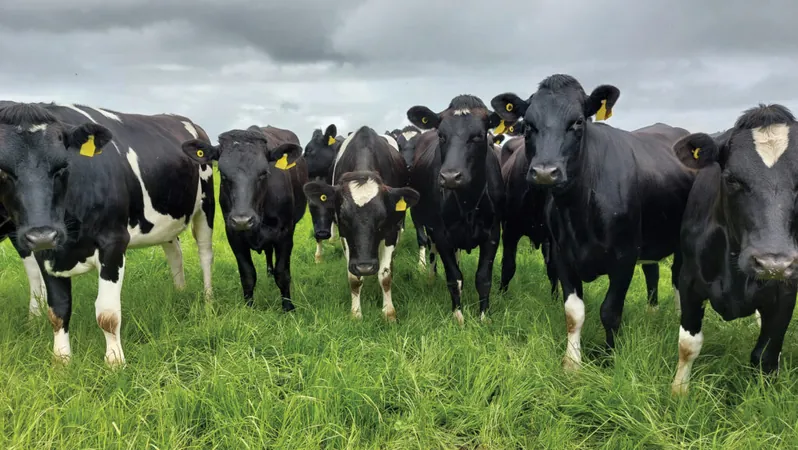
The Crucial Benefits of Pain Relief for Heifers at Calving: A Game-Changer for Dairy Farms!
2025-03-31
Author: Mei
Introduction
New research reveals that administering a pain relief injection to heifers immediately after calving is not just a luxury—it's a vital step that can significantly enhance their transition into the milking herd and prevent serious health issues, such as metabolic diseases and lameness.
Importance of Pain Management
Veterinary expert Annemarie Fitzgerald underscores the importance of pain management in livestock welfare, highlighting that cattle, being prey animals, often mask signs of pain. This means that they may be suffering in silence during crucial transitional phases in their lives. It's essential for dairy farmers to recognize this and take proactive measures.
Effects of Calving on Stress Levels
When a cow goes through the calving process, its blood cortisol levels—an indicator of stress and pain—naturally rise. Unfortunately, if these levels remain elevated due to stressors like assisted births or competition for feed and space, it can lead to complications. The benefits of improved transition periods cannot be understated; as Fitzgerald points out, addressing these issues can lead to healthier heifers with lower incidences of lameness.
Practical Solutions for Dairy Farms
In typical farming scenarios where separate facilities for first-lactation heifers are unavailable, Fitzgerald suggests a practical workaround: calving heifers in pairs. This encourages social support, allowing them to bond with a companion as they adjust to the more competitive environment of the main herd.
Research on NSAID Benefits
While there is no direct evidence yet to mandate the routine use of non-steroidal anti-inflammatory drugs (NSAIDs) for first calvers, ongoing research from the University of Nottingham indicates substantial advantages. Over a study period of 34 months, heifers that received NSAIDs during their first calving showed a significantly decreased likelihood of being culled or diagnosed with lameness.
Risks of Systemic Inflammation
This is particularly relevant as calving trigger systemic inflammation, which can damage soft tissues—such as ligaments in the tail head and the feet—leading to chronic conditions. Damage to the digital cushion, a critical fat pad that supports foot structure, can occur primarily immediately after calving, which is when it is thinnest and most vulnerable.
Challenges for Younger Heifers
Moreover, the pressure on digital cushions increases when younger heifers mix with older, larger cows, forcing them to stand longer and increasing their risk of lameness. The analogy Fitzgerald uses poignantly captures this: It's like starting secondary school—a stressful and overwhelming transition.
Ensuring Comfort for Heifers
To ensure that heifers are comfortable, eating well, and able to rest, pain relief is essential. This not only mitigates the physical pain associated with calving but also combats common post-calving issues such as ketosis and displaced abomasum.
Conclusion
For dairy farmers, there is a strong argument to engage in conversations with veterinarians to identify specific risks associated with their farms. By analyzing the cost-benefit of implementing routine NSAID usage for freshly calved heifers, they can consider how this investment compares to potential losses—whether in milk production or the costs of treatment for poorly transitioning heifers.
Ultimately, every heifer that successfully navigates its first lactation cycle is an investment in the farm's future profitability. Pain relief injections may be a simple step but could represent a turning point in enhancing overall herd health and productivity. Don't wait—act now for a healthier, more productive future on your farm!
 Brasil (PT)
Brasil (PT)
 Canada (EN)
Canada (EN)
 Chile (ES)
Chile (ES)
 Česko (CS)
Česko (CS)
 대한민국 (KO)
대한민국 (KO)
 España (ES)
España (ES)
 France (FR)
France (FR)
 Hong Kong (EN)
Hong Kong (EN)
 Italia (IT)
Italia (IT)
 日本 (JA)
日本 (JA)
 Magyarország (HU)
Magyarország (HU)
 Norge (NO)
Norge (NO)
 Polska (PL)
Polska (PL)
 Schweiz (DE)
Schweiz (DE)
 Singapore (EN)
Singapore (EN)
 Sverige (SV)
Sverige (SV)
 Suomi (FI)
Suomi (FI)
 Türkiye (TR)
Türkiye (TR)
 الإمارات العربية المتحدة (AR)
الإمارات العربية المتحدة (AR)